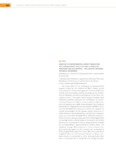Please use this identifier to cite or link to this item:
http://www.alice.cnptia.embrapa.br/alice/handle/doc/1068248| Title: | Analysis of environmental impact indicators, best management practices and technology adoption for HLB control: the view of horchard technical managers. |
| Authors: | RODRIGUES, G. S.  STUCHI, E. S.   ALBUQUERQUE, A. F. A. de   BARIZON, R. R. M.   GIRARDI, E. A.   |
| Affiliation: | GERALDO STACHETTI RODRIGUES, CNPMA; EDUARDO SANCHES STUCHI, CNPMF; AUREA FABIANA A DE ALBUQUERQUE, CNPMF; ROBSON ROLLAND MONTICELLI BARIZON, CNPMA; EDUARDO AUGUSTO GIRARDI, CNPMF. |
| Date Issued: | 2016 |
| Citation: | In: INTERNATIONAL CITRUS CONGRESS, 13., 2016, Foz do Iguaçu. Sustainable citriculture: the role of applied knowledge: abstract book. Campinas: IAC; Londrina: IAPAR, 2016. Resumo S6-254. |
| Pages: | p. 84-85. |
| Description: | This study refers to the assessment of environmental impacts caused by the incidence of HLB in Brazil, as well as the adoption of Good Management Practices (GMP) and specific actions of disease control, according to the verification of indicators carried out with groups of technical consultants in citrus. The multi-criteria analysis (Ambitec-Agro method) comprises indicators for verification of (i) environmental impacts of HLB on citrus production (38 indicators); (ii) adherence to GMP recommended in the Technical Standards for Integrated Citrus Production (NTEPIC, IN no. 42 of 07/07/2008) (89 indicators); and (iii) the adoption of specific technologies for the disease control, based on scientific literature recommendations and the ?ten commandments to control HLB? (FUNDECITRUS, 2015) (31 indicators). Thirty technical advisors expressed their knowledge about the average levels of HLB incidence, its impacts and control practices for a productive universe represented by 130.840 ha, corresponding to approximately 67 million plants. The weighted average HLB incidence in these orchards (several producing regions in the country) was estimated at 8.3%, ranging from under 5% to over 20%. The multicriteria weighted index of environmental impacts of disease incidence (scale ±1) amounted to -0.12, with particular reference to increased use of chemicals and energy consump-tion. The weighted index of conformity with the NTEPIC reached 69%, while the weighted recommended adoption of HLB control practices reached 58%. Recommendations of actions to mitigate environmental impacts and optimize management practices for HLB control have been proposed, based on these estimates, as guides for improved technical action by the consultants and assisted farmers. |
| NAL Thesaurus: | Best management practices |
| Keywords: | Impact assessment HLB control BPM Environment assessment |
| Type of Material: | Resumo em anais e proceedings |
| Access: | openAccess |
| Appears in Collections: | Resumo em anais de congresso (CNPMA)  |
Files in This Item:
| File | Description | Size | Format | |
|---|---|---|---|---|
| 2016RA052.pdf | 87.79 kB | Adobe PDF |  View/Open |









